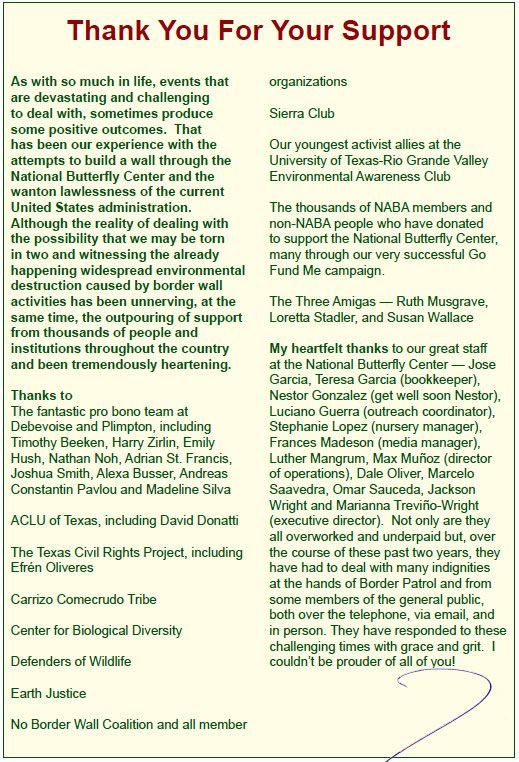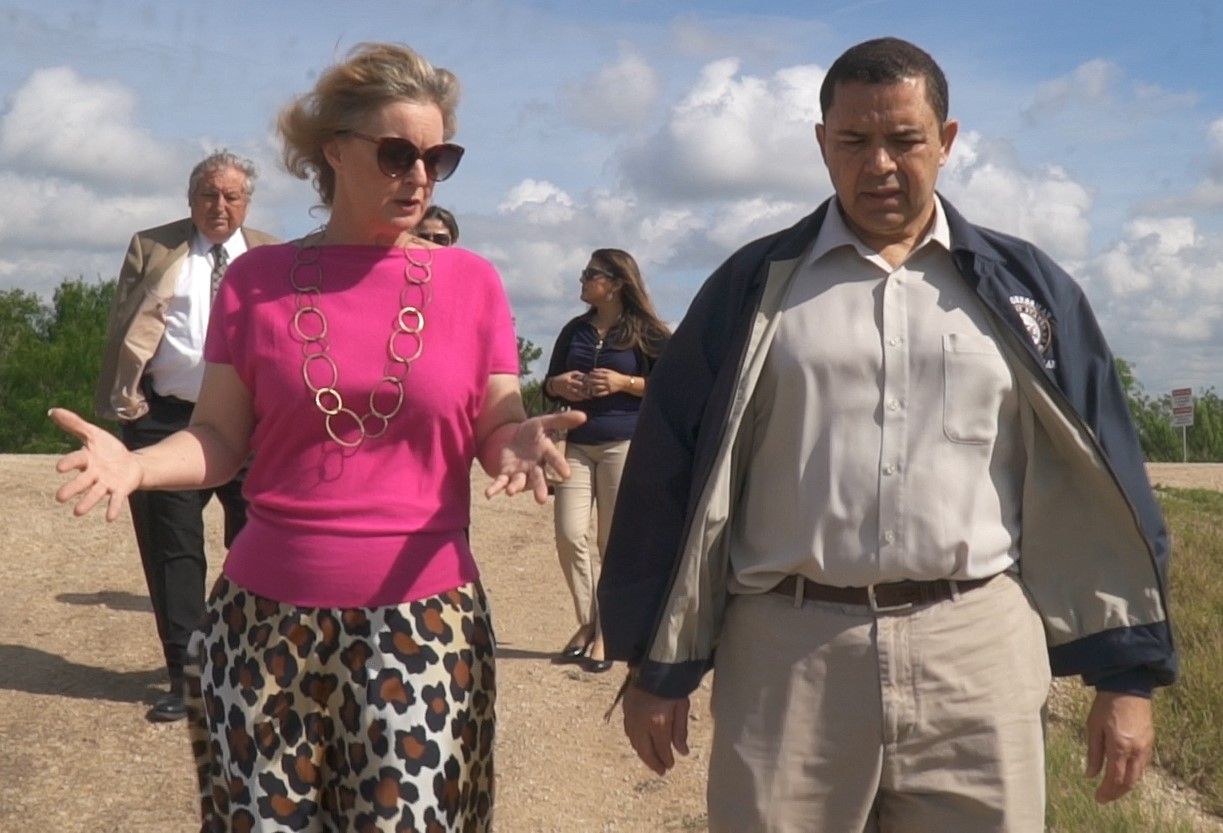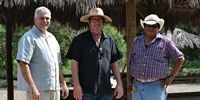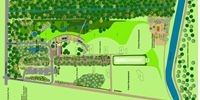National Butterfly Center Hits a Wall—And Keeps Going
As Published in American Butterflies, Summer 2019
A pre-dawn awakening ahead of a beautiful day at the National Butterfly Center, used to be filled with anticipation of Guatemalan Crackers, Malachites and an untold measure of magnificent creatures!
Each morning was filled with dew and a long list of ‘to-dos’, designed to keep us growing. Staff meetings focused on guest experience, educational programs and maintenance tasks, inventory management and upcoming events. Not so long ago, I felt attuned to the seasonal changes of the place, the peculiar rhythm of the plants, never static, and the special magic of the center, bustling with happy energy and contagious curiosity from members and schoolchildren.
But that was before the battle for border wall began.
In retrospect, I relished the routine—that routine—before the ‘disaster tourists’ and MAGA hats started showing up, asking us to show them where Trump’s monument would be built from sea to shining sea.
For those who have not followed us on Facebook or seen the stream of headlines related to the “Butterflies vs. the Border Wall,” allow me to bring you up to speed on how your project and our mission have been affected by a national agenda in direct conflict with environmental conservation.
Several months after President Trump was inaugurated in 2017, we began to experience aggression and harassment from Border Patrol. By this, I mean our employees and visitors were subject to illegal stops and vehicle searches, intimidation and questioning, and the unlawful denial of access to part of the property. We found this exceptionally odd, given the fact that we have been here for more than a decade and had cultivated a cooperative relationship with the local field office. At this time, we even had a pair of dedicated Border Patrol Community Liaison agents assigned to us to support communication and security.
Late that June, our director of operations, Max Muñoz, and two employees crossed the levee on our property during regular business hours to survey plants and collect seeds. They were promptly surrounded by four Border Patrol units, lights flashing and commands shouting, even though all staff vehicles are on file with Border Patrol by make, model, year, color, license plate and photographs.
One month later, on July 20, 2017, I went over the levee with a vendor only to discover five workmen from Tikigaq, an Alaskan corporation, cutting down trees, mowing vegetation and widening the dirt road on our property. When I asked them what they were doing, they explained the government had sent them to “clear this land from the levee to the river ahead of the border wall,” where we had recently planted more than 5,000 native milkweed and nectar plants to establish the Southernmost Monarch Waystation. This was nine months before any Congressional vote or appropriation authorizing border wall construction.
The days and weeks that followed were surreal. On July 21, 2017, five Border Patrol agents arrived at the center demanding to speak with me. When we met, they told me what I was claiming happened on our property had not happened. I asked them to get in their trucks and follow me to the area just south of the levee where the Tikigaq crew had left their Brush Hog and Brush Boom. There the agents observed the heavy equipment, as well as the felled trees and other damage done by their contractor. They told me someone from the Customs & Border Protection Real Estate Office would be in touch right away.
About a week later, on August 1, 2017, I had a meeting scheduled with representatives from the CBP Real Estate Office, only to receive a text message that the meeting had to be cancelled because they were “not ready to meet” with me. To my surprise, the former chief of the Rio Grande Valley Sector of Border Patrol, Manuel Padilla, showed up that morning instead. He came unannounced, in plain clothes, to inform me the government had indeed sent the contractors to clear our land and they would return in the future “with green uniform presence” to prevent me from running them off or interfering with their work. When I pressed Chief Padilla about this, “Would you really send armed, federal agents to stop private property owners from asking questions of employees from for-profit companies—send government agents to guard these private interests?” He replied, “People tend to get pretty upset when we use eminent domain to seize their land.”
Padilla also told me the first border wall construction in a decade would begin at the National Butterfly Center and surrounding properties because we represented “the path of least resistance.” He said our section of the Lower Rio Grande Valley Wildlife Conservation Corridor, which includes Bentsen-Rio Grande Valley State Park and two National Wildlife Refuge Tracts, involved the fewest private property owners, therefore, the government intended to start here.
At this point, we realized we were actually Ground Zero for Trump’s campaign promise, a vanity project we knew would achieve none of its purported objectives, like preventing immigrants from entering the United States. How did we know? Because none of the border wall built a decade ago in South Texas has stopped people, drugs or weapons from landing on U.S. soil. How could it, when it is built more than two miles inland in some areas (as it will be now), so that anything and anyone that comes across the Rio Grande River—the international boundary—and lands on the shore is in the USA. This is not our opinion of the efficacy of border wall, here; it is fact, unless President Trump makes the border wall the new international border and cedes thousands of square miles of our country to another, as he appears all too willing to do with our only source of freshwater, the Rio Grande.
Immediately, we began to gather resources to prepare for the onslaught. First, I called the offices of our senators and representative. Senator John Cornyn (R) sent his South Texas Regional Director and Community Outreach Advisor Ana Garcia to see me. I was shocked to learn she did not know the border wall was not built on the border, but inland, leaving Texans—U.S. citizens—with land south of the barrier. In fact, she was completely unaware that entire residential subdivisions, farms and businesses were effectively cut off from the United States by the border wall, where sections were already built. Senator ‘Ted’ Cruz (R) did not respond to requests for meetings, nor did any representative of his office. When I called the office of Representative Henry Cuellar (D) I was handed over to Mr. Stacy Forbes, a Fellow from the Department of Homeland Security who serves on Cuellar’s staff. When I explained what Customs & Border Protection had done on our property, he was worse-than-rude, asking, “And? What do you want me to do about it?”
At this point, I was authorized by my superiors to have a full title examination done for the property and seek experienced legal counsel. Dr. Glassberg, president of the board of the North American Butterfly Center (NABA), secured pro bono representation for us, thanks to the assistance of NABA member and attorney, Harry Zirlin, an Associate at Debevoise & Plimpton; while I reached out to the Texas Civil Rights Project, a nonprofit, social justice organization with lawyers who represented landowners in the Lower Rio Grande Valley when President George W. Bush’s border wall was built in 2008-2011. Our lawyers then led us in a crash course concerning the Immigration & Nationality Act of 1952, the REAL ID Act of 2005, the Secure Fence Act of 2006, the modern use of eminent domain, and all things related to border wall litigation.
As the fall of 2017 passed, we watched the unveiling of Trump’s border wall prototypes in San Diego from a distance with incredulity, only to laugh as these “impenetrable” and “unscalable” walls were breached, time and time again, in testing. In spite of all the rhetoric to the contrary, we hoped common sense would rule the day and Congress would deny Trump’s desire to “Build that Wall!” Then, in the midst of the federal budget battle for border wall, Border Patrol Agent Rogelio Martinez was mysteriously killed near Big Bend, literally, in the middle of nowhere, Culberson County, Texas; 3,813 square miles of desert with a population of 2,236.
Since the formation of Border Patrol in 1904, only 123 agents have died in the line of duty. Of the 123, only 47 have died as the result of any type of assault, with the overwhelming majority dying from “illness”, like heart attacks, and on-the-job accidents. Although National Border Patrol Council spokesman Art Del Cueto publicly denounced the politicization of Martinez’s death; another union spokesman, Chris Cabrera, echoed the president’s baseless claims, asserting Martinez and his partner were struck by rocks in a violent attack, likely by undocumented immigrants or drug traffickers—a claim that has since been disproven by multiple law enforcement agencies.
On November 19, 2017, Trump tweeted, “We will, and must, build the WALL!” in response to Martinez’s death, and we knew the proverbial shoe had dropped.
On December 9, 2017, following notice of our intent to sue and the 60-day waiting period required by the federal government for any party seeking legal redress to a grievance, we filed suit against the Trump Administration and the Department of Homeland Security for statutory and Constitutional claims, based upon their egregious acts at the National Butterfly Center. If NABA was Plaintiff #1, I was definitely Plaintiff #2, and the press took notice. Word of our lawsuit spread like wildfire, prompting hundreds of media requests. Our phones rang incessantly with inquiries and more than a few angry “patriots” making threats against me, personally, and the center. The holidays came and went without much of a break from all the hoopla and what seemed like a hundred-thousand ignorant comments about how “butterflies can fly over the wall.”
In January, 2018, after a three-day government shutdown, Congress got down to wheeling-and-dealing in earnest. This activity culminated on March 23, 2018, when Trump received $641,000,000 for 25 new miles of “levee fencing” in the Rio Grande Valley Sector in the Consolidated Appropriations Act, 2018, which passed the House and Senate with bi-partisan support.
In another strange twist, politicians and pundits boasted on television and in print that Trump had been defeated on the border wall front, with “no funding allocated for new walls,” but we knew this was false. “Levee fencing” is border wall, by virtue of the scheme concocted a decade ago by our own Congressman Cuellar. Indeed, “levee fencing” has nothing to do with our levee system, except in the government’s attempt to exploit language in the levee easement in order to circumvent private property rights, a despicable plot for which Cuellar claimed credit in a September 19, 2017, meeting he hosted for local officials.
In truth, all “levee wall” and “levee fencing” belong to the Office of Border Wall Program Management under the Department of Homeland Security and are classified as their “tactical infrastructure” for immigration enforcement, not flood control. This is why the government cannot simply build the “levee wall” in the levee easement; rather, they must acquire the land for this project from private property owners by compensation and/or condemnation.
In June, I flew to Washington, D.C. to meet with Congressional staffers about border wall funding, where many of them continued to assert there was no border wall in South Texas, and no funding for new border wall; so, this exercise in frustration mostly involved educating the people responsible for informing our elected officials who enact policy for our country. It was disheartening, to say the least. Add to this the fact that Border Patrol was not releasing maps to the public or any information to affected landowners showing wall placement or design, a timetable for construction, or anything, rendering us fairly handicapped in proving our case.
All of this changed at the beginning of July, when an ally at Defenders of Wildlife in New Mexico, received an undated letter from Paul Enriquez, Real Estate and Environmental Branch Chief, U.S. Customs & Border Protection, United States Border Patrol, Office of Border Wall Program Management Office, Program Management Office Directorate. This letter not only included maps showing where CBP intended to place the new border wall, but described our wall, which would be approximately 18’ of concrete wall with 18’ steel bollards on top. It also gave basic information about the 150’ wide enforcement zone, the all-night lighting, the cameras, gates and new patrol road. All this showed Trump’s wall would be taller, more destructive, and require the seizure of more land than any previous border barrier.
On August 8th, I attended the Quarterly Landowner & Stakeholder Meeting at the McAllen Border Patrol Station, as I had done for the past six years. This meeting was packed with landowners and others I’d never seen before because Loren Flossman, manager of the Border Wall Program Management Office, was present. As landowner after landowner asked questions about the border wall, with some unaware it had been funded and the government had already published the solicitation for construction bids in the Federal Register, Flossman finally announced no more questions would be answered in the meeting. He stated, “If you have levee on your property, you are getting levee wall.” We were all instructed to schedule appointments with members of his staff, as there would be no public meetings and questions would only be answered in private meetings with affected landowners.
It was all downhill from there, as they say.
October 8, the Secretary of Homeland Security waived 28 federal laws, including the National Environmental Policy Act, the Clean Water Act and the Endangered Species Act to expedite border wall construction in Hidalgo County.
October 29, President Trump announced the deployment of over 5,000 active duty, U.S. military troops to the southern border, ahead of the mid-term elections.
November 6, Election Day, the Department of Homeland Security awarded SLSCO of Galveston, Texas, a $145 million contract to build 5.5 miles of border wall through the National Butterfly Center and surrounding properties.
December 3, the environmental and archeological surveyors showed up at the center to conduct their sham surveys. Each for-profit company employee was guarded by a Border Patrol agent.
December 18, Dr. Glassberg and I met on the levee at the center with three representatives from DHS and CBP who were accompanied (guarded) by 5 uniformed Border Patrol agents.
January 16, I testified before the House Natural Resource Conservation Committee concerning the devastating impact of border wall destruction on the Lower Rio Grande Valley Wildlife Conservation Corridor, the National Butterfly Center, our community, our economy and our natural resources.
February 3, Super Bowl Sunday, the heavy equipment intended to de-vegetate our land for border wall construction began rolling in. It was parked overnight on the private property belonging to Mike Rhodes, next door to us.
February 4, Dr. Glassberg and I met with two representatives of Valbridge Property Advisers, hired by the government to appraise our land for eminent domain proceedings. These two were guarded by four uniformed Border Patrol agents, with another six agents “stopping by” to check on them.
February 11, Foremost Paving & Construction began methodically turning all of the trees and every living thing in them into mulch at the La Parida Banco NWR tract adjacent to Bentsen-Rio Grande Valley SP.
February 12, the International Boundary & Water Commission sent a crew to install signs on the levee on our property that said, “U.S. Government Property No Trespassing.”
Then, on February 13, I received a totally unexpected call from Stacy Forbes in Congressman Cuellar’s office. He called to tell me Cuellar had secured language in the 2019 DHS Spending Bill that clawed back the 2018 appropriation for border wall at the National Butterfly Center, as well as Bentsen-Rio Grande Valley State Park, La Lomita Mission, Santa Ana NWR, and Space X at Boca Chica Beach. I know he expected me to rejoice at the good news, but we already understood this was not a saving, but a temporary stay of execution. I thanked Stacy for the congressman’s work on our behalf, then asked him about the fake “state of emergency” news outlets were reporting the president planned to declare.
February 14, U.S. District Court Judge Richard Leon summarily dismissed our lawsuit against the federal government, more than 14 months after it was filed and without us ever receiving a single hearing. That’s right, we never got a minute in court to present our case.
February 15, Trump declared a State of Emergency at the southern border in order to circumvent Congress and take unauthorized monies—up to $8 billion—from federal agencies and programs to fund his border wall. As these monies were not appropriated by Congress, they came without restrictions; so, this put us right back in the crosshairs for destruction.
April 15, the steel bollard panels that will be set atop the 18’ concrete wall started arriving at a storage lot permitted for a “landscaping company” on Conway Avenue, where they continue to be stacked high, just down the road from us.
May 14, As reported in the Washington Post, CNN and other outlets, Trump, along with Advisors Stephen Miller and son-in-law Jared Kushner, met in the Oval Office with Senators to discuss the president’s new immigration plan, ostensibly crafted by Miller and Kushner. In response to less than favorable feedback from those present, Kushner reportedly boasted, “We solved the butterfly thing,” referring to the administration’s plan to build border wall through our property.
In the latest development in this saga (as of drafting), on May 24, a federal court blocked Trump’s use of monies garnered under his State of Emergency declaration for border wall construction.
We are sure the administration will appeal this decision. Meanwhile, we’re headed into another federal budget battle, with the possibility—dare I say likelihood—of a third government shutdown, should Trump not get what he wants.
In the past, my updates to all of you have included wonderful news related to successful events, grant awards, beneficial programs and plantings. Alas, since the government contractors darkened our door in July, 2017, I’ve had no time to devote to grantwriting. Instead, I’ve made three trips to Washington, D.C. and one to Austin, all to educate and advocate on behalf of NABA. Still, we produced two great Texas Butterfly Festivals, and expect to do so again, this November. And in April, 2020, we will be launching the Wild Gardening Festival at the National Butterfly Center, a spring fling in South Texas, when the wildflowers are at their showy peak and the landscape should be ripe with butterflies, birds and blooms.
As always, your support has carried us through. Although we’ve lost a few members who feel “no sacrifice is too great” to build the border wall, who would apparently have us shutter; we’ve gained more who learned of us only as a result of this fight and the furious work we’ve done to help people understand how futile—obscene, even—the border wall is.
There is plenty I’ve left out of this report, ranging from official corruption and criminal conduct, to art installations and acts of solidarity in protest of the wall, but you get the idea and you will get the gate code to pass through the border wall, if it is ever built across the property.
Many of you have written and called, sending thoughtful messages of encouragement and concern for my state of being. At this point, I feel like that tattered and tossed butterfly that’s way beyond her glory days. You’ve all seen those individuals, the ones you aren’t sure whether to pity or congratulate for the state they’re in!
It’s been a wild ride, but I am not ready to fold it up. The National Butterfly Center is truly a treasure. It is something many of you have poured your hard-earned money and hope for the future into. For this reason, I will continue to defend it, vigorously, proclaiming, “She who fights and flies away, lives to flit another day.” #Resist












 Media
Media